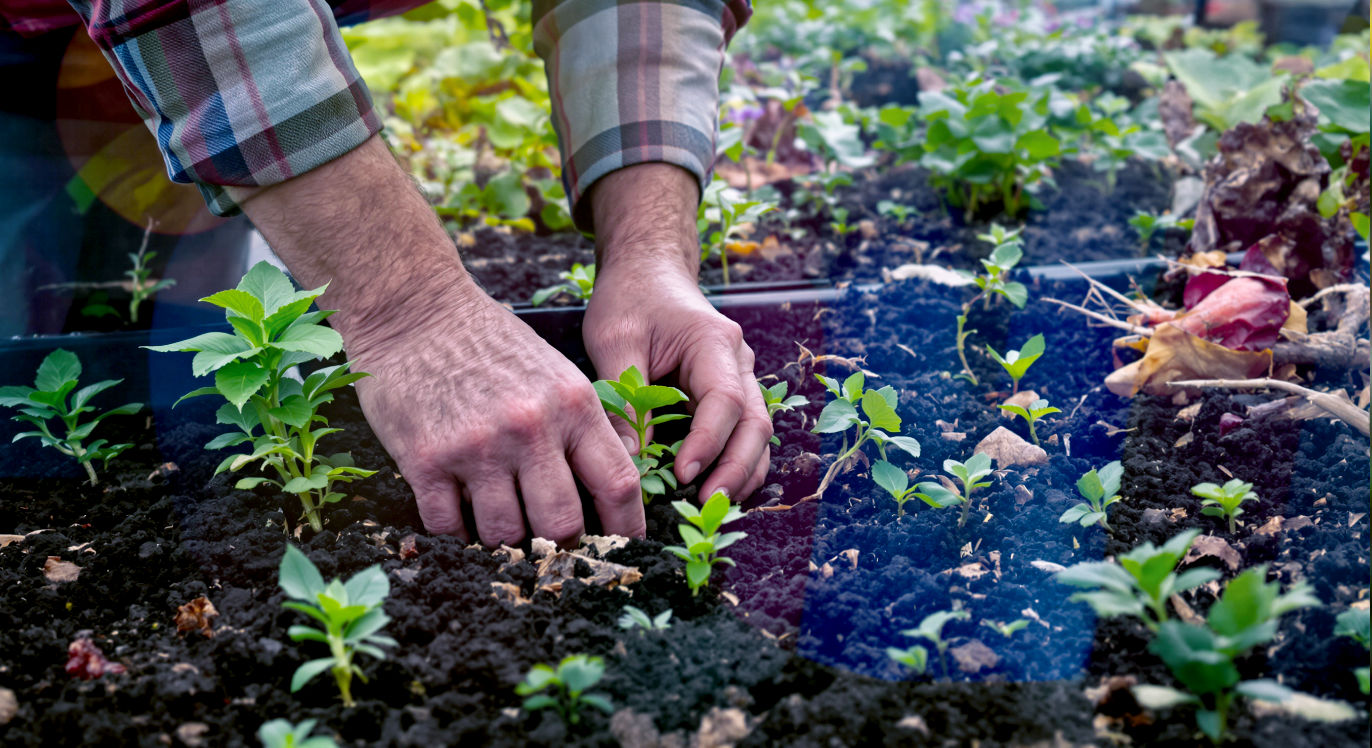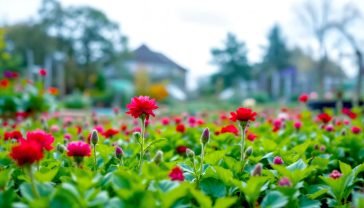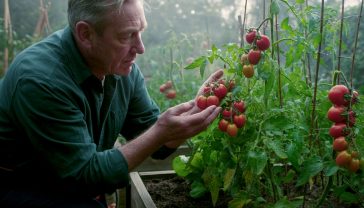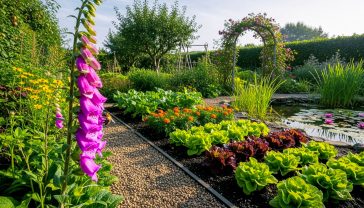The Great British Dig: How Crop Rotation Keeps Our Soil Happy and Our Veggies Thriving
Learn the secrets of crop rotation, the organic practice that transformed British farming and can revolutionize your garden. A complete guide for UK growers.

This post may contain affiliate links. If you make a purchase through these links, we may earn a commission at no additional cost to you.
Ever wondered how your nan’s garden seems to churn out perfect spuds and crunchy carrots year after year, without turning into a patch of tired, dusty earth? Or how farmers keep their fields from getting exhausted? Chances are, they’re using a secret weapon that’s as old as the hills but as clever as the latest bit of tech. It’s called crop rotation, and it’s one of the cornerstones of brilliant gardening and farming.
Think of it like a very slow, very green dance. Instead of planting the same thing in the same spot every year, you move your crops around in a planned sequence. It sounds simple—and it is—but this clever shuffle is doing something amazing for the soil beneath our feet. It’s a natural way to keep pests and diseases at bay, stop the soil from running out of puff, and grow healthier, tastier food. It’s not just a dusty old technique from the history books; it’s a vital part of modern organic farming and something any British gardener can master to get the best out of their patch, whether it’s a sprawling allotment or a few pots on the patio.
So, let’s dig in and uncover the simple genius of crop rotation, exploring how this ancient practice transformed British farming and how you can use it to bring a little bit of harmony to your own garden.
What on Earth is Crop Rotation, Anyway?
At its heart, crop rotation is a beautifully simple idea: don’t plant the same family of vegetables in the same piece of ground year after year. Instead, you divide your growing space into sections and move each family of crops to a new section each year, following a logical cycle.
Imagine you’ve got a small vegetable patch divided into four beds. In the first year, you might plant potatoes in bed one, beans in bed two, cabbages in bed three, and carrots in bed four. The next year, you’d shuffle them all along. The potatoes move to where the beans were, the beans to where the cabbages were, and so on. The carrots would loop back around to the first bed. You’d continue this rotation every year.
It’s like making sure your soil gets a balanced diet. Different plants have different needs and different effects on the ground they grow in. Some are greedy feeders, while others actually put goodness back.
The Science Bit, Made Simple
To understand why this works so well, we need to think about what’s happening underground. The soil isn’t just dirt; it’s a living, breathing ecosystem packed with billions of tiny organisms, nutrients, and minerals. Growing plants is a bit like having guests for dinner—some are very polite, while others eat everything in the fridge.
- The Greedy Guts (Heavy Feeders): Plants like potatoes, cabbages, broccoli, and leeks are the hungry teenagers of the vegetable world. They slurp up a lot of nutrients from the soil, especially nitrogen, which is vital for leafy green growth. If you plant them in the same spot repeatedly, they’ll strip the soil bare, leaving it weak and unproductive. It’s like trying to make tea with the same teabag over and over—it gets weaker every time.
- The Givers (Nitrogen-Fixers): This is where it gets really clever. Plants from the legume family—think peas, broad beans, French beans, and runner beans—have a superpower. They have special nodules on their roots that contain bacteria capable of taking nitrogen from the air and ‘fixing’ it into the soil. They are the generous guests who bring a lovely bottle of wine to the party. Planting them in a bed enriches the soil, leaving it packed with free fertiliser for the next crop in line.
- The Light Nibblers (Light Feeders): Root vegetables like carrots, parsnips, and beetroot don’t need as much nitrogen. In fact, too much nitrogen can make them grow lots of leafy tops but disappointing, forked roots. They are happy to follow the greedy guts, mopping up the leftover nutrients.
- The Soil Improvers: Some crops, like potatoes, are great for breaking up heavy clay soil because you have to dig the ground over thoroughly to plant and harvest them. This improves the soil’s structure, making it better for the crops that follow.
By rotating these groups, you’re creating a sustainable system. The nitrogen-fixing beans prepare the ground for the hungry brassicas, whose leftovers are then happily used by the root vegetables. It’s a perfect, harmonious cycle.
Why Bother? The Three Big Wins of Crop Rotation
This agricultural dance isn’t just for show. It delivers three massive benefits that have made it a cornerstone of sustainable farming for centuries.
1. Pest and Disease Control: Breaking the Cycle
Many garden nasties, from tiny eelworms to fungal diseases like clubroot, are picky eaters. They specialise in attacking one particular family of plants. For example, clubroot is a fungus that infects the roots of brassicas (cabbages, broccoli, cauliflower), causing them to become swollen and distorted, which stunts the plant’s growth. Onion white rot is another soil-borne fungus that devastates onions, garlic, and leeks.
These pests and diseases can build up in the soil over time. If you plant the same crop in the same spot year after year, you’re essentially laying out an all-you-can-eat buffet for them. Their populations explode, and your crops suffer.
Crop rotation is the ultimate party pooper for these pests. When you move the brassica family to a new bed, the clubroot spores left behind in the old bed have nothing to feed on. Over the next few years, their numbers dwindle as they starve. By the time the brassicas return to that spot (usually in three or four years), the threat has been massively reduced. It’s a simple, organic, and incredibly effective way to manage pests without reaching for a chemical spray.
2. Soil Fertility: A Balanced Diet for Your Garden
As we’ve seen, different plants take different things from the soil. Constantly growing one type of crop is like only eating crisps—eventually, you’ll be missing some essential vitamins.
- Nutrient Management: Rotation allows the soil to recover. By following heavy feeders with light feeders or, even better, with nitrogen-fixing legumes, you’re managing the soil’s nutrient bank account. The legumes make a deposit, the brassicas make a big withdrawal, and the roots use what’s left in the current account. It prevents any one nutrient from being completely depleted.
- Improving Soil Structure: The system also helps the physical structure of the soil. The deep taproots of crops like parsnips can help break up compacted soil, improving drainage and aeration. The dense, fibrous root systems of beans add organic matter when they rot down, making the soil more crumbly and better at holding water. Digging for potatoes naturally cultivates the ground. Each plant family leaves the soil in a slightly different state, and a good rotation plan uses this to continuously improve the ground.
3. Weed Suppression: Giving Weeds a Headache
Weeds are the uninvited guests at the garden party, and they can be a real pain. Different crops, with their different growth habits and timings, can help keep them under control.
For instance, planting a dense, leafy crop like potatoes or squash will quickly create a canopy of leaves that shades the soil surface. This makes it much harder for weed seeds to germinate and grow, effectively smothering them. A crop like onions, which is tall and thin, offers much less competition.
A good rotation plan will alternate between crops that are good at suppressing weeds and those that are less effective. You can also time your cultivation. For example, the ground for maincrop potatoes is often dug and prepared later in spring, which gives you a chance to clear out the first flush of annual weeds. By changing the planting and harvesting times each year, you disrupt the life cycles of different weeds, preventing any single type from getting the upper hand.
A Very British Revolution: How Rotation Changed Our Landscape
Crop rotation might seem like simple common sense now, but its widespread adoption in Britain was a revolutionary leap forward that fuelled massive social and economic change. For centuries, British farming was stuck in a rut, using a medieval ‘two-field’ or ‘three-field’ system. Farmers would leave a third of their land fallow—empty—each year to allow it to recover its fertility. It was inefficient and wasted a huge amount of precious land.
The Dawn of a New Agriculture
Things started to change in the 17th and 18th centuries, during a period we now call the British Agricultural Revolution. Landowners and farmers began experimenting with new ideas, many of them inspired by practices in the Low Countries (modern-day Belgium and the Netherlands).
One of the most famous pioneers was Charles Townshend, a Norfolk landowner who earned the nickname ‘Turnip Townshend’ in the 1730s. He wasn’t the first to grow turnips, but he was a brilliant publicist for a new system of farming called the Norfolk four-course rotation.
This system was pure genius in its simplicity. A field would go through a four-year cycle:
- Year 1: Wheat (a cash crop for bread).
- Year 2: Turnips (a root crop to feed livestock over winter).
- Year 3: Barley (another cash crop, often used for beer!).
- Year 4: Clover (a legume to replenish soil nitrogen and provide grazing).
Why the Norfolk System Was a Game-Changer
The Norfolk four-course rotation solved several problems at once.
- No More Fallow Land: Every field was productive every single year. This dramatically increased the amount of food that could be grown.
- Livestock and Crops in Harmony: The turnips and clover provided winter fodder for animals. This meant farmers could keep more livestock, which in turn produced more manure—a fantastic natural fertiliser that was spread on the fields to boost the grain crops. It created a virtuous cycle of fertility.
- Weed Control: Growing turnips in rows allowed farmers to hoe between them, clearing out weeds far more effectively than was possible in a dense wheat field.
- Improved Soil: The clover, being a legume, pumped nitrogen back into the soil, naturally fertilising it for the wheat crop that followed.
This system, and others like it, spread across the country. It led to a huge surge in food production, which was essential for feeding the rapidly growing population of the towns and cities during the Industrial Revolution. It literally changed the face of the British countryside, creating the patchwork of fields we know today and laying the foundations for modern, productive farming.
Your Turn: Planning a Simple Crop Rotation for a British Garden
Right, enough history. How do you actually put this into practice in your own garden or allotment? It’s much easier than it sounds. The key is to think in terms of plant families, because members of the same family are often susceptible to the same pests and diseases and have similar nutritional needs.
Step 1: Know Your Veg Families
You don’t need a degree in botany, but it helps to know the main groups. Here are the most common ones you’ll be growing in the UK:
- Legumes (The Givers): Peas, broad beans, French beans, runner beans. They fix nitrogen.
- Brassicas (The Greedy Guts): Cabbage, cauliflower, broccoli, Brussels sprouts, kale, swede, turnips, radish, rocket. They love nitrogen and are prone to clubroot.
- Onions (The Allium Family): Onions, garlic, leeks, shallots. Prone to onion white rot and leek rust.
- Potatoes (The Solanum Family): Potatoes, tomatoes, peppers, aubergines. These are also heavy feeders and can suffer from potato blight. (Note: While botanically related, tomatoes are often grown separately in a greenhouse, so they might not be in your main rotation).
- Roots (A Mixed Bunch): Carrots, parsnips, beetroot, celery, fennel. They generally don’t like soil that’s too rich or freshly manured. Carrots and parsnips are particularly targeted by the carrot root fly.
Step 2: Sketch a Simple Plan
The easiest way to start is with a three-year or four-year rotation. Grab a piece of paper and draw your veg patch, dividing it into three or four equal-sized beds. If you only have one big patch, just imagine it’s divided.
A Classic Four-Year Rotation Plan
This is a great, robust system that covers all the main groups.
- Bed 1: Legumes. Peas and beans. They’ll fix nitrogen in the soil.
- Bed 2: Brassicas. Cabbages, broccoli, etc. They will love the nitrogen left by the beans.
- Bed 3: Potatoes & Onions. Potatoes and the onion family. Both are hungry, but you can put the onions and leeks in after the spuds have had the richest soil.
- Bed 4: Roots. Carrots, parsnips, and beetroot. They will do well in soil that has had its nitrogen levels reduced by the previous crops.
How it works year-by-year:
| Year | Bed 1 | Bed 2 | Bed 3 | Bed 4 |
|---|---|---|---|---|
| Year 1 | Legumes | Brassicas | Potatoes/Onions | Roots |
| Year 2 | Roots | Legumes | Brassicas | Potatoes/Onions |
| Year 3 | Potatoes/Onions | Roots | Legumes | Brassicas |
| Year 4 | Brassicas | Potatoes/Onions | Roots | Legumes |
Preparing the beds: Before you plant, you can give each bed a boost.
- For the Legumes: They don’t need rich soil, so just a light compost is fine.
- For the Brassicas: They are hungry! After the legumes are finished, dig in plenty of well-rotted manure or garden compost in the autumn to prepare the bed for them.
- For the Potatoes/Onions: They also love rich soil. Add another good layer of compost or manure before planting.
- For the Roots: Do not add manure to this bed! It can cause the roots to fork. They will be perfectly happy with the nutrients left over from the potatoes. Just rake it level before sowing.
A Simpler Three-Year Rotation Plan
If you have less space or want to keep things really simple, a three-bed system works brilliantly too.
- Bed 1: Legumes & Onions.
- Bed 2: Brassicas & Potatoes.
- Bed 3: Roots.
The principle is the same. Just move each group along one bed each year. The golden rule is simple: Legumes -> Brassicas/Potatoes -> Roots.
Common Pitfalls and How to Avoid Them
- What about the odd ones out? What about things like courgettes, pumpkins, lettuce, and sweetcorn? These crops aren’t too fussy and don’t suffer from many soil-borne diseases, so you can usually slot them in wherever you have a bit of space. Courgettes and pumpkins are greedy feeders, so they do well on the brassica or potato beds. Lettuce can be tucked in almost anywhere.
- Perennial Veg: Some vegetables, like asparagus, rhubarb, and globe artichokes, stay in the same place for many years. Give them their own permanent bed outside of the main rotation.
- I forgot what I planted where! This is the most common problem. The solution is simple: write it down. Keep a small notebook or a diagram of your plot and label what went where each year. It will be your most valuable gardening tool.
- My beds aren’t the same size. Don’t worry. The principle is more important than geometric perfection. Just do your best to group the families and move them to a different area of soil each year.
- What about pots and containers? You can still practice crop rotation! The easiest way is to simply replace the compost in your pots each year. This gets rid of any potential disease build-up and ensures your plants have fresh nutrients. If you have several large containers, you can try to rotate what you grow in them.
Crop Rotation in the 21st Century: Beyond the Veg Patch
Crop rotation isn’t just a historical curiosity or a handy tip for gardeners. It’s a fundamental principle of organic and regenerative agriculture, movements that are trying to find more sustainable ways to feed the world.
Modern industrial farming often relies on monoculture—growing vast fields of the same crop year after year. This is efficient in the short term, but it can lead to huge problems. Soil becomes depleted and requires massive inputs of artificial fertilisers. Pests and diseases can thrive, necessitating the heavy use of chemical pesticides. This can damage wildlife, pollute waterways, and contribute to soil erosion.
A Return to Smarter Farming
Farmers in the UK and around the world are increasingly looking back to principles like crop rotation to build more resilient and environmentally friendly systems.
- Cover Crops and Green Manures: Modern rotations often include ‘cover crops’ like phacelia or grazing rye. These aren’t harvested but are grown specifically to protect and improve the soil. They are planted in a field between main cash crops, preventing soil from being left bare and vulnerable to erosion from the British wind and rain. When they are dug back into the ground, they add valuable organic matter. This is known as green manuring.
- Mixed Farming: Just like in the days of ‘Turnip’ Townshend, integrating livestock back into crop systems is making a comeback. Animals can graze on cover crops, and their manure provides a natural, slow-release fertiliser, reducing the need for synthetic alternatives.
- Biodiversity: Complex rotations involving a wide variety of crops help to support a greater range of wildlife, from pollinators like bees to the worms and microbes that are the unseen engineers of healthy soil. This creates a more balanced and resilient farm ecosystem.
The challenges are huge, of course. Supermarkets and global supply chains demand uniformity and predictability, which can make diverse rotations tricky for large-scale farmers. But the principles of working with nature, rather than against it, are more relevant than ever as we face the challenges of climate change and the need to protect our precious natural resources.
The Final Dig: A Legacy of Harmony
Crop rotation is more than just a gardening technique. It’s a philosophy. It’s about understanding that the soil is not an inert substance to be exploited, but a living partner in the process of growing food. It teaches us to think in cycles, not just straight lines, and to see the connections between what we take out and what we put back in.
From the revolutionary fields of 18th-century Norfolk to a modern allotment in Newcastle, the principle remains the same. By orchestrating a simple, patient dance of plants, we can build fertile soil, keep pests at bay, and grow wonderful, healthy food. It’s a quiet, powerful harmony between the gardener, the crops, and the earth itself—a legacy of wisdom that is just as vital for our future as it was for our past.
Further Reading
For those keen to dig deeper into the world of organic gardening and soil health, these resources are highly respected in the UK:
- The Royal Horticultural Society (RHS): The UK’s leading gardening charity, their website is an encyclopaedia of reliable, science-backed advice on crop rotation and all other aspects of gardening. www.rhs.org.uk
- Garden Organic: A UK charity dedicated to researching and promoting organic growing. They offer fantastic, practical advice for gardeners of all levels. www.gardenorganic.org.uk
- The Soil Association: The UK’s main organic certification body. Their website is a great resource for understanding the principles of organic farming and its benefits. www.soilassociation.org
- Charles Dowding’s No Dig Gardening: Charles Dowding is a leading voice in the UK for the ‘no dig’ method, which works hand-in-hand with crop rotation to build incredible soil health. His website and YouTube channel are treasure troves of practical advice. www.charlesdowding.co.uk






